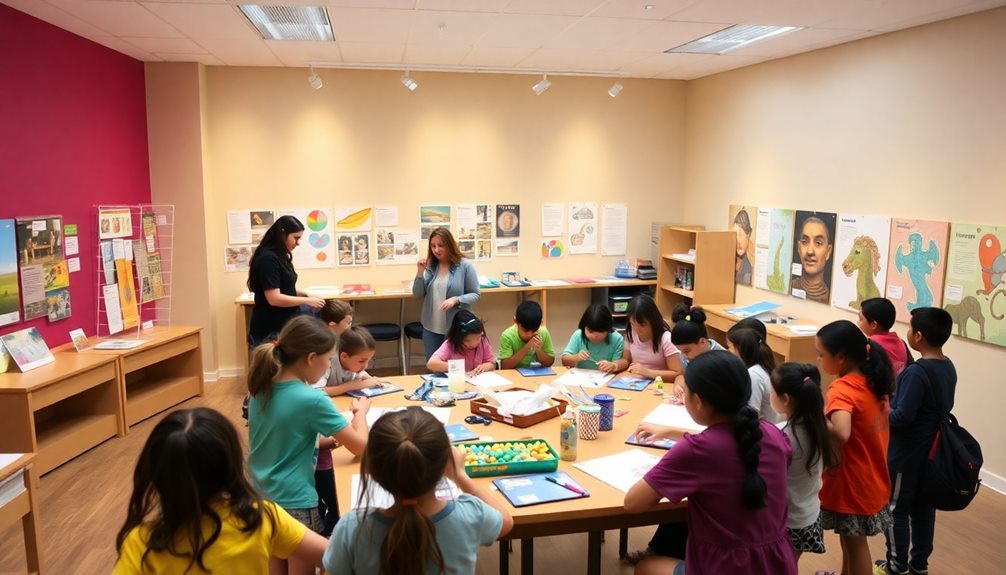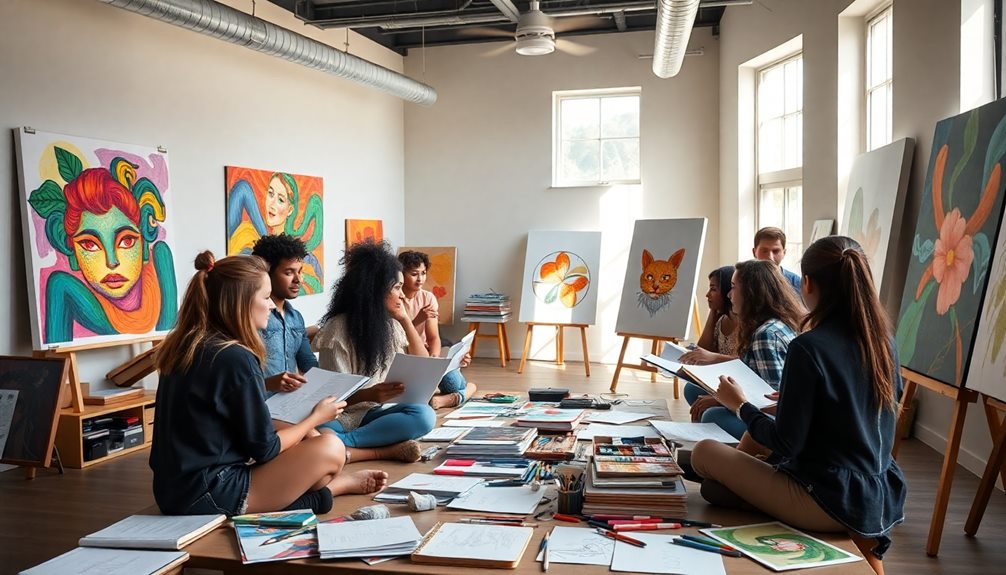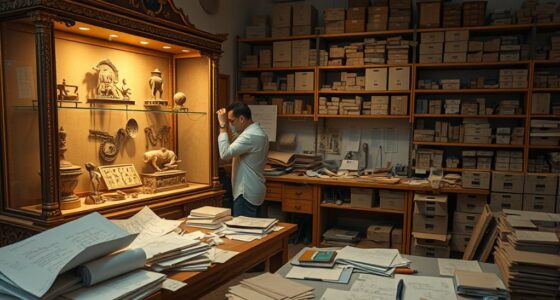Museum education programs turn visits into engaging learning experiences for a variety of audiences, including families and educators. These structured activities are designed with clear goals and themes, ensuring balance between educational objectives and visitor interests. Effective planning, marketing strategies, and regular evaluations are essential to keep programs impactful and relevant. By integrating state curriculum standards, these programs meet educators' needs while appealing to students. Offering diverse workshops and learning opportunities, museums advocate for educational inclusion and community engagement. There's so much more to explore about how these programs work and their benefits for all involved.
Key Takeaways
- Museum education programs enhance learning through collections, catering to diverse audiences and balancing educational goals with visitor interests.
- Effective programs require clear purposes, strong thematic development, and careful logistical planning, ideally initiated four months in advance.
- Engaging content created using storytelling and visual elements captures audience attention and maintains interest across various demographics.
- Regular assessments and audience feedback are essential for evaluating program effectiveness and guiding improvements for future initiatives.
- Collaborating with local schools and utilizing digital marketing strategies maximize visibility and engage target audiences effectively.
Definition of Museum Education Programs
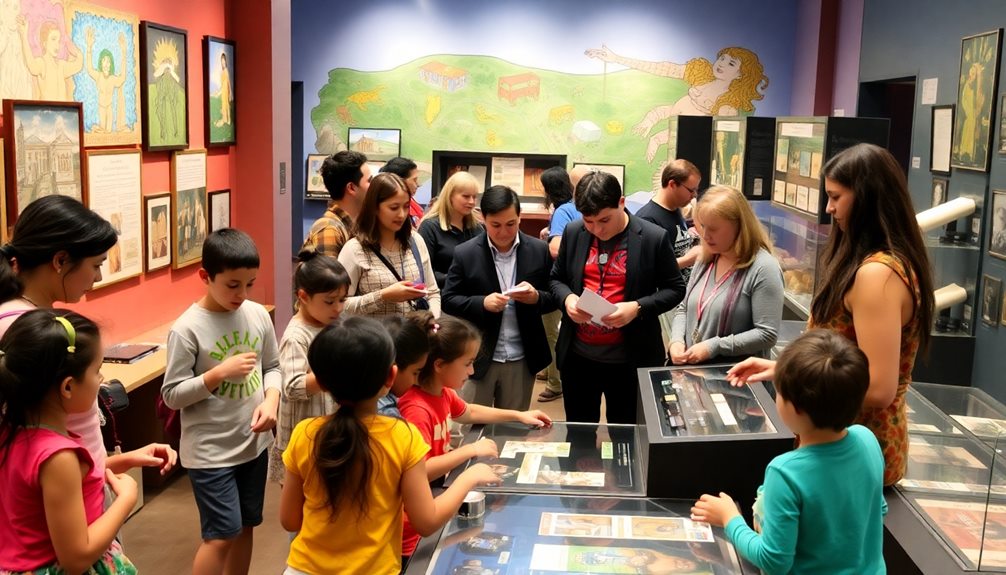
Museum education programs are structured activities designed to enrich your learning experience by connecting you directly with a museum's collections. These educational programs are carefully planned and cater to diverse audiences, including families, students, and adults.
Unlike casual social events, they've clear learning objectives that enhance your understanding and appreciation of the exhibits. Approximately 97% of Americans view museums as valuable educational assets, highlighting the importance of these programs in fostering engagement and learning.
Museum professionals work diligently to guarantee that each program balances educational goals with the interests and experiences of visitors like you. This thoughtful approach helps create a meaningful learning experience, making your time at the museum more impactful.
What sets museum education programs apart is their audience specificity. They require advance planning and are designed to engage you actively, unlike regular exhibits where passive observation is common.
Key Components of Effective Programs

When you're planning a museum education program, it's essential to define your purpose and goals clearly.
A strong thematic development not only enhances visitor engagement but also guides the program's effectiveness.
Additionally, careful logistical planning guarantees everything runs smoothly, making it easier to achieve those objectives.
Program Purpose and Goals
Creating a successful museum education program hinges on a clear purpose that directs every aspect of your initiative. Your program purpose and goals should guide the audience focus, learning objectives, and the overall impact you aim to achieve. By defining these elements, you set the foundation for engaging experiences that resonate with visitors.
Effective programs incorporate strong themes that convey broad concepts. This guarantees ethical interpretation of your educational assets, leaving a lasting impression on participants. Remember, balancing the goals of museum educators with the interests of your audience is essential for crafting meaningful learning experiences. Regular assessments will help you determine the effectiveness of your initiatives, allowing for adjustments as needed.
Logistics also play an important role in your planning process. Detail your execution strategies to maintain structure and flow, which affects various departments and budgets. Aim for at least four months of advance planning to guarantee thorough structuring and a successful program launch.
Thematic Development Importance
Thematic development serves as the backbone of effective museum education programs, shaping the way visitors engage with content and concepts. A strong theme conveys broad ideas that enhance clarity and effectiveness, guaranteeing ethical and sensitive interpretive processes. By establishing well-defined themes, you help shape audience focus and learning objectives, making the program's impact clear and relevant.
Moreover, thematic development fosters a deep understanding of the subject matter, going beyond simple facts. This approach encourages interdisciplinary learning and engagement with museum collections, allowing visitors to connect diverse ideas and perspectives.
When you implement a compelling theme in your educational programs, it can considerably elevate audience engagement, leading to increased participation and retention in museum initiatives.
Ultimately, the importance of thematic development lies in its ability to create lasting impressions on visitors. By thoughtfully integrating themes into your museum exhibitions, you're not just presenting information; you're crafting a meaningful experience that resonates long after the visit.
Prioritizing thematic development guarantees your educational programs are impactful, relevant, and memorable for everyone involved.
Logistical Execution Planning
Successful museum education programs require careful logistical execution planning to guarantee a smooth visitor experience. When organizing field trips or special events, detailed execution strategies are crucial. You'll want to define the program's structure and flow clearly, ensuring everything runs seamlessly.
Address logistical hurdles early on; overwhelming decisions can affect multiple departments and budgets, risking the integrity of your museum programs.
A structured program planning timeline, ideally set four months in advance, allows for thorough preparation. This foresight increases the chances of a successful launch.
During the execution phase, maintaining regular communication between departments is essential. It helps align objectives, resources, and responsibilities, fostering a unified approach to program delivery.
Post-execution evaluation of logistics is essential. Reviewing resource allocation and staff training can reveal areas for improvement, enhancing future offerings.
Marketing Strategies for Visibility
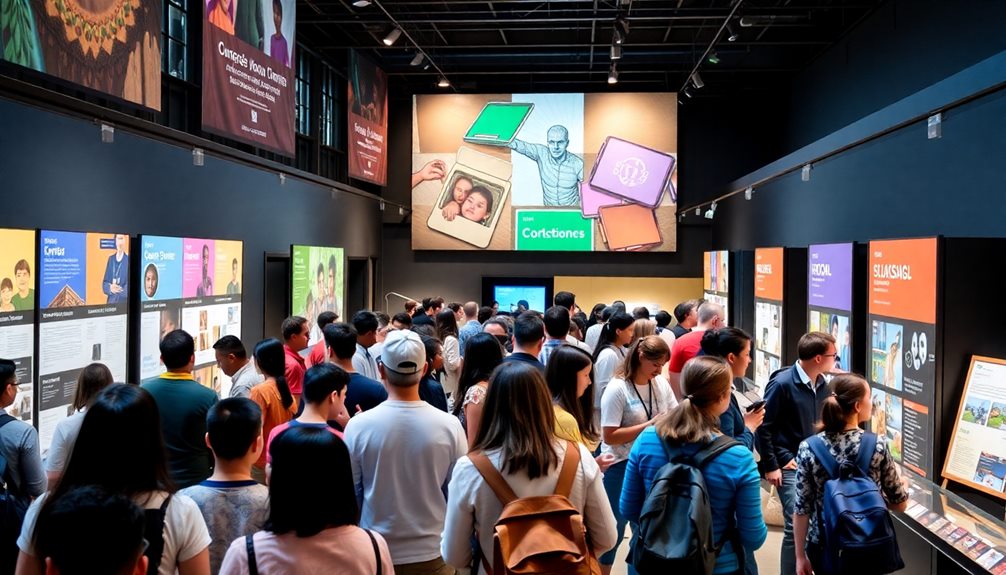
To boost visibility for your museum education programs, you need to identify your target audience first.
Once you know who you're trying to reach, you can choose effective channels and create engaging content that resonates with them.
This focused approach will help draw in more visitors and enhance attendance for your programs.
Target Audience Identification
Identifying your target audience is vital for crafting effective marketing strategies that boost the visibility of museum education programs. By focusing on target audience identification, you can tailor your programs to meet specific interests and demographics, which ultimately increases engagement and attendance.
Start by analyzing audience data from surveys or past attendance; this will help you guide your marketing efforts and make certain your promotional materials resonate with potential visitors.
Collaborating with local schools, community organizations, and cultural groups can also enhance visibility. These partnerships not only promote museum education initiatives but also reach diverse audiences that might otherwise remain unaware of your offerings.
Don't underestimate the power of digital outreach. Leveraging social media platforms and online marketing channels is essential for connecting with younger audiences, as studies show this greatly boosts program awareness and participation rates.
Effective Channel Selection
Choosing the right channels for your marketing strategy can make all the difference in promoting museum education programs. Without effective outreach, you risk low attendance rates among your target audiences.
Many museum educators may lack marketing expertise, especially in smaller institutions, making it essential to select the most effective channels for visibility. To maximize your reach, consider identifying lucrative niches within your community that align with your programs.
To enhance your marketing efforts, consider these key strategies:
- Social Media Platforms: Use platforms like Facebook, Instagram, and Twitter to connect with your audience and share engaging content.
- Email Newsletters: Regularly send out newsletters to keep your audience informed about upcoming programs and events.
- Community Partnerships: Collaborate with local organizations and schools to reach a broader audience and boost awareness.
- Audience Feedback: Regularly gather feedback through surveys or informal conversations to evaluate the effectiveness of your marketing strategies.
Engaging Content Creation
Creating engaging content is essential for capturing your audience's attention and driving interest in museum education programs. Start by crafting compelling blurbs that highlight the unique aspects of your programs. Use vivid language to evoke curiosity and excitement, ensuring that potential attendees can easily grasp what makes your offerings special.
Additionally, consider utilizing email marketing strategies to enhance your outreach and keep your audience informed.
Visuals matter too. Create eye-catching graphics that reflect the essence of your programs. High-quality images, infographics, or videos can notably enhance your message and make your content more shareable on social media platforms.
When selecting marketing channels, consider where your target audience spends their time. Social media and email newsletters are powerful tools for boosting visibility. Regularly share updates, testimonials, and behind-the-scenes content to keep your audience engaged and informed.
Collaborating with local schools and community organizations can extend your reach and help promote your museum education programs effectively.
Planning and Curriculum Standards

Successful museum education programs often require careful planning and a solid understanding of curriculum standards. When you design your program, keep in mind that while curriculum standards shouldn't dictate everything, aligning with them can greatly enhance your educational offerings.
Here are some key points to take into account:
- Plan Ahead: Aim for a structured program planning timeline, ideally starting at least four months in advance. This allows for thorough preparation.
- Utilize State Guides: Integrate state curriculum guides to tailor lessons that meet specific classroom needs, making your program relevant to educators.
- Balance Creativity and Standards: Embrace innovative approaches in your programming, but make sure they adhere to curriculum standards to foster greater engagement.
- Collect Feedback: Regularly assess and gather feedback from your audience to refine your programs, making certain they remain impactful and relevant.
Evaluation and Resource Management
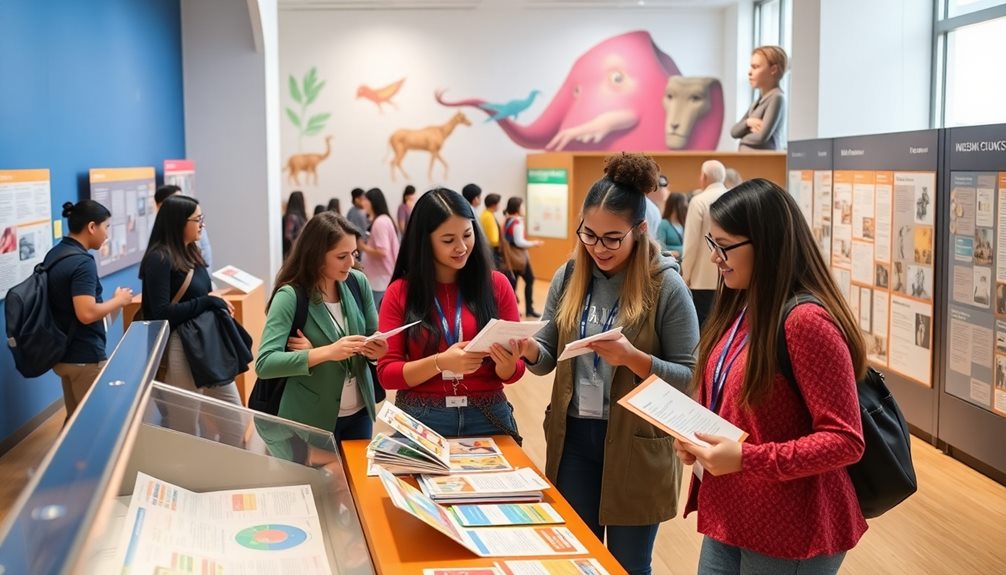
Effective evaluation and resource management are vital components of any museum education program. Regular assessment helps you determine the program's effectiveness and guarantees it meets visitor needs. By collecting data, you can make informed decisions that enhance educational value.
It's essential to evaluate not just the educational impact but also the financial performance, as revenue generation plays a significant role in deciding which programs to retain.
Audience feedback is invaluable in this process. Gathering insights from your visitors can guide improvements and adaptations, ensuring your programs resonate with the community. If a program underperforms, consider retiring it in a timely manner. This frees up resources and staff time for new initiatives, keeping your museum education relevant and impactful.
To support effective program development and management, utilize available resources like an Educator Resource Library and a Program Planning Checklist. These tools can streamline your efforts while respecting user privacy through easy unsubscribe options.
Balancing evaluation with resource management not only optimizes your current offerings but also sets the stage for innovative educational experiences in the future.
Learning Opportunities and Workshops

While exploring the vast educational offerings at museums, you'll find a wealth of learning opportunities and workshops designed to engage learners of all ages. The Houston Museum of Natural Science (HMNS) excels in providing immersive experiences that enhance student engagement through hands-on learning.
Whether you're a teacher seeking resources or a student enthusiastic to explore, there's something for everyone.
Here are some key offerings you shouldn't miss:
- Field Trips: Experience unique, hands-on learning environments with real dinosaur fossils and interactive chemistry activities, all designed to complement your academic curriculum.
- Summer Camps: For kids aged 6-12, these camps focus on exciting topics like physics, coding, and paleontology, led by distinguished teachers to foster educational engagement.
- Workshops for Educators: Take part in TEKS-aligned outreach programs that bring museum experiences directly into your classroom, supporting essential curriculum standards.
- Scouts Program: Engage in badge classes and enrichment field trips that promote self-confidence, ethics, and values through educational activities.
These opportunities not only enrich your learning experience but also support your professional development as an educator.
Advocacy and Community Engagement
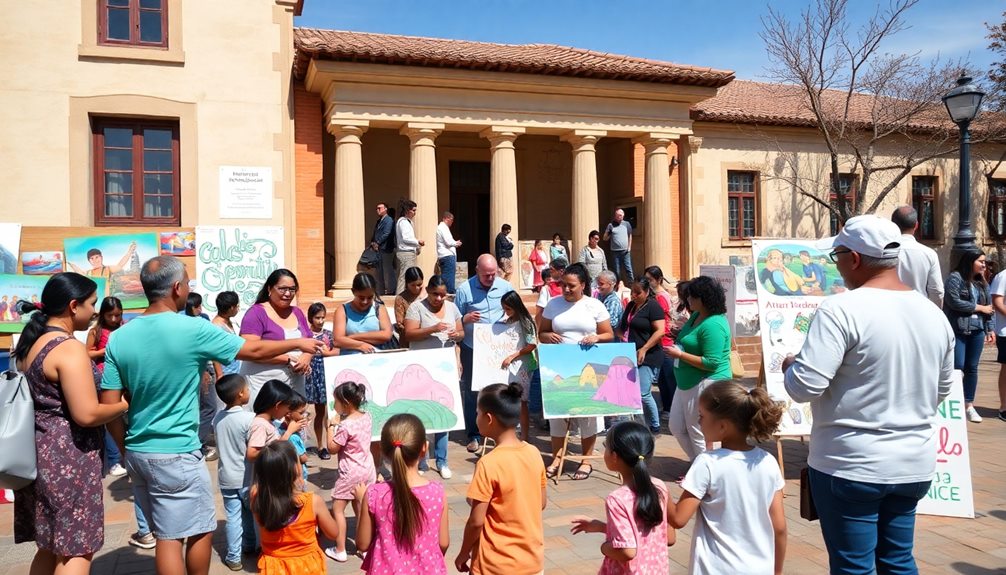
Museums play an essential role in shaping educational landscapes, and their involvement in advocacy and community engagement amplifies this impact. By advocating for the inclusion of museums in education policy discussions, you help guarantee that their contributions to student learning are recognized and supported.
This advocacy not only highlights the value of museum education programs but also secures funding for initiatives that benefit both the institutions and their communities.
Organizing local convenings can facilitate collaboration between museum staff and education providers, enhancing community engagement and resource sharing.
When you identify strategies for community integration, you leverage museum resources effectively, enriching local educational experiences.
Promoting partnerships between museums and schools fosters collaboration that enhances learning ecosystems.
These partnerships broaden educational opportunities for students, making museum education a crucial component of their academic journey.
Frequently Asked Questions
What Are the Best Degrees to Work in Museums?
To work in museums, you'll find degrees in Museum Studies, Art History, or Cultural Heritage valuable. Consider advanced degrees for specialization, as they enhance your skills in curating, education, and management, making you more competitive.
Is a Degree in Museum Studies Worth It?
A degree in Museum Studies is definitely worth it if you're passionate about culture and education. It equips you with essential skills, enhances your employability, and opens diverse career opportunities within the vibrant museum sector.
What Makes a Good Museum Educator?
A good museum educator balances educational goals with visitor interests. You'll engage your audience through strong communication, continuously develop your skills, align programs with standards, and evaluate effectiveness to enhance learning experiences for everyone involved.
How Much Do Museum Educators Make in the US?
Museum educators in the U.S. typically earn between $40,000 and $60,000 annually. Entry-level positions start around $35,000, while experienced educators can make $70,000 or more, depending on the institution and location.
Conclusion
In summary, museum education programs are essential for fostering a love of learning and connecting communities. By focusing on effective components, smart marketing, and rigorous planning, you can create experiences that are as unforgettable as a blockbuster movie. Remember to evaluate your efforts and engage with your audience to guarantee ongoing success. Embrace the myriad opportunities available, and watch your programs flourish as you inspire countless minds and hearts to explore the wonders of the world!
